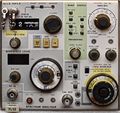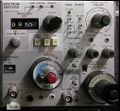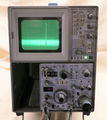7L12: Difference between revisions
No edit summary |
No edit summary |
||
| Line 13: | Line 13: | ||
* [[Media:Tek 7L12 factory cal december 1972.pdf|Tektronix 7L12 Factory Calibration Procedure]] | * [[Media:Tek 7L12 factory cal december 1972.pdf|Tektronix 7L12 Factory Calibration Procedure]] | ||
* [[Media:26W-4889.pdf]] | * [[Media:26W-4889.pdf]] | ||
* [[Media:26AX-3582-3.pdf|FM Broadcast Measurements Using the Spectrum Analyzer]] | |||
}} | }} | ||
Revision as of 14:04, 16 November 2019
The Tektronix 7L12 is a 1.8 GHz Spectrum Analyzer plug-in for 7000-series scopes. It is a double-width plugin to be installed in the right vertical and left (or only) horizontal bay.
Early models had a mechanical reference level readout. Later, front panel outputs for 1st and 2nd LO were added to allow connecting a TR501 or TR502 tracking generator. Late models had LED reference level readout.
The 7L12 does not have the UNCAL indicator typical for spectrum analyzers that alerts the operator when the sweep speed is too fast for the given resolution. The manual advises to use the variable control to reduce sweep speed until the signal amplitudes don't change.
The Tek catalogs suggested the 7603 Opt.06 or 7613 Opt.06 as suitable mainframes.
Key Specifications
| Input frequency | 100 kHz – 1.8 GHz (Opt.39: 2.5 GHz) |
|---|---|
| Span | 500 Hz/Div – 100 MHz/Div |
| Sweep | 1 μs/Div to 5 ms/Div (1-2-5) |
| Resolution bandwidth | 300 Hz – 3 MHz in decade steps |
| Sensitivity | -115 dBm at 300 Hz |
| Vertical scale | 10 dB/Div, 2 dB/Div or linear |
| Reference level | -100 dBm – +30 dBm |
| Video filters | 30 kHz, 300 Hz or 3 Hz |
| Features |
|
Internals
The 7L12 is a traditional triple-mixing spectrum analyzer design. The input signal runs through a step attenuator (0 to 60 dB in 10 dB steps), a 1.8 GHz low-pass filter and a 3 dB pad (to isolate the mixer from LPF reflections) to a 1st mixer. The 1st LO is a YIG oscillator running at 2.095 GHz to 3.9 GHz, resulting in a 2.095 GHz 1st IF. This IF passes through a "traveling wave damper" (isolator), a 2.2 GHz LPF and a 10 MHz wide 2.095 GHz bandpass filter before reaching the 2nd mixer. The 2nd LO oscillates at 2.2 GHz (variable by +/- 1 MHz) for a 2nd IF of 105 MHz, which is amplified, then filtered in a 3-stage helical filter with 3 MHz bandwidth before passing through a 3rd mixer to the final 10 MHz IF, variable resolution filters, and post-resolution amplifier to the "Function IF amplifier" that implements the linear or logarithmic detector.
A phase lock circuit controls the 1st LO at spans of 0.1 MHz/Div and less, tying its frequency to a multiple of 2.21 MHz using a diode sampler employed as a mixer. The sampling gate is driven by an avalanche pulser. In phase lock, the 2nd LO is swept instead of the 1st. The fine frequency control is only operational in phase lock mode, one of the key limitations of this design.
The 7L12 includes a standard sweep circuit built around the 155-0056-00 Sweep Control (U1140) and 155-0042-02 (U1160) Miller Integrator custom ICs. The 7L12 also uses the TEK-custom quad opamp 155-0035-00 in several places.
Prices
| Year | 1971 | 1980 | 1984 | 1988 |
|---|---|---|---|---|
| Catalog price | $4,850 | $6,500 | $10,250 | $12,500 |
| 2015 value | $28,100 | $18,760 | $23,460 | $24,800 |
Mods
Links
- Tekscope Vol. 4 No. 1, Jan 1972
- Tek 7L12 @ amplifier.cd
- Tek 7L12 @ barrytech.com
- 7L12 videos: #1 / #2 / #3 / #4
Pictures
-
7L12, later version with LED reference level display, front
-
Left side
-
Top view
-
Right side
-
Right side toward front. The 1st mixer (bottom left) and 1st LO (large cylindrical can) are visible.
-
Bottom view
-
Bottom front
-
Bottom center. The 3-stage 2nd IF 105 MHz helical filter is visible in the middle (black cylinders).
-
Top front
-
Tektronix 7L12, center board extended
-
Tektronix 7L12, center board extended, back side. 2nd IF (105 MHz) helical filter seen near bottom.
-
7L12 105 MHz Helix filter. From Tekscope, Jan 1972
-
later and early model side by side
-
early model
-










